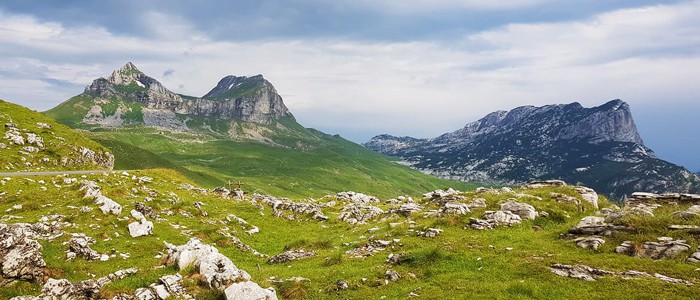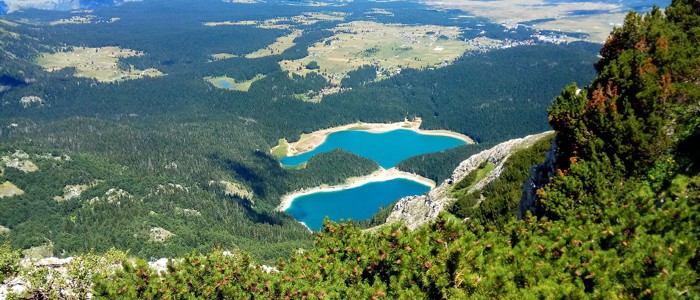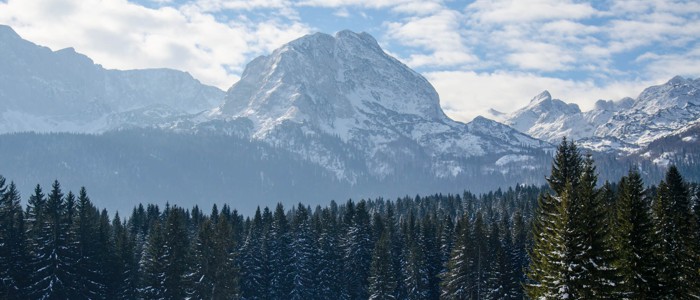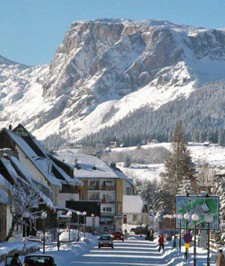Durmitor is the most beautiful and the most exotic mountain summer resort in Montenegro. It has been proclaimed a national park owing to the beauty of its lakes, its deep canyons, its peaks covered with snow, its vast deciduous and evergreen woods, its thick pastures.
Next to Prokletije, Durmitor is the highest massif of the Dinaric mountain system. It is one thousand metres higher than its foot which is at an altitude of 1500 metres, on a flat highland, into which the steep-sided and deep riverbeds of the Piva, the Tara, the Sušica and the Komarnica are cut, all of which represent the headwaters of the river Drina.

The first sight of Durmitor is magnificent, regardless of where you approach it from. If you come from the direction of Pljevlja (crossing the bridge at Djurdjevića Tara) it is equally beautiful as if you come from the direction of Nikšić over Krnovo, which is famous for its storms and its snowdrifts. The visitor arrives onto a spacious highland, greeted by the gigantic peaks of Durmitor high up in the clouds. That highland is also called “the highland of lakes”, for the Durmitor region is one of the richest in small lakes on the Balkan Peninsula. There are more than twenty of these lakes originating from former glaciers, and they can be found at an altitude of 1400 to 2200 metres. The largest and the most attractive are: Black Lake, Valovito, Pošćansko, Vražje, Srablje, Riblje and Zmijsko. Black Lake (Crno Jezero) under the massif Medvjed, which is 700 metres higher than the surface of the lake is the most beautiful. It consists of the big and the small lake. The small lake is about 450 metres long, and about 260 metres wide, and it is connected with the big lake, which is 830 metres long, and about 520 metres wide. Black Lake is about 48 metres deep, surrounded by dense evergreen forests and very rich in trout.

The highest peak of Durmitor is Babotov Kuk or Cira's Cave, a true stone pyramid 2522 metres high; then there are Sljeme (2477 m), Pruta (2393 m), Soje (2388m). Other peaks are: Malin Bogaz, Savin Kuk, Kobilja Glava, Medvjed, and Crvena Greda. The view from these peaks of valley, gorges, clefts, and steep rocks, as well as of the four winding mountain rivers, and numerous slopes covered with snow, which even in summer can serve for skiing competitions, is unforgettable. The colourful “belts” are probably the most beautiful part of the Durmitor massif. These stone layers stretching from bottom to top create a wonderful picture. The Ice Cave, which is at an altitude of 1900 metres and luxuriously decorated by stalactites and stlagmites is exceptionally attractive. One of the “wonders of nature” is Sava’s Waters, a source at an altitude of 2000 metres, the highest source in our country.

Hunting is very developed on Durmitor. All kinds of game live in its woods and on its stony slopes. There are bears, wild boar; roe deer, chamois, foxes, hares… On the lakes, both in winter and in summer, one can find various kinds of wild fowl. During the severe winter months, wild animals often descend to villages and larger settlements, running away from snowdrifts.

At the bottom of Durmitor, close to the Black Lake, on a large highland, the small picturesque town of Žabljak is situated. It was built in 1871, at the highest altitude on the Balkan Peninsula (1450 metres). During the National Liberation War the Partisan Headquarters was at Žabljak for some time in the course of the 4th and 5th enemy offensives.
Žabljak has an Alpine climate. The average temperature is 5°C. There is snow during 120 days in a year and its healthy mountain climate, its romantic winters, its rivers and lakes and the beauty of its landscape give Žabljak a very important place in the tourist economy of Montenegro. Žabljak is a centre of winter tourism and a starting point for the mountaineers who climb to its peaks and visit its lakes, skiing grounds and summer pastures. Above this natural park, at an altitude of 1465 metres, is the “Durmitor” hotel, which was built in the style of mountain houses.

Not far from Žabljak, in the vicinity of the village of Javorje, there is a gigantic tree, Javor's grove, which the people from this region are very proud of. A hundred boys and girls can dance a “kolo” under its canopy without getting wet even in the hardest rain. Splendid Durmitor and its surroundings will presently become one of the centres of an intensly developed tourist economy.
